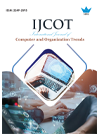Cognitive Relay Networks using Primary User Interference for efficiency
Citation
Ms. Archana R Gani, Miss. Madhura M R"Cognitive Relay Networks using Primary User Interference for efficiency", International Journal of Computer & organization Trends (IJCOT), V5(3):22-25 May - Jun 2015, ISSN:2249-2593, www.ijcotjournal.org. Published by Seventh Sense Research Group.
Abstract Actually interference occurs from Secondary Users to Primary Users with some efficiency, relations beginning from Primary Transmitters to Secondary Users. Consider both the interference which occurs from Secondary Users to Primary receivers and primary Transmitters to Secondary Users with using opportunistic relay based on primary user interference. In proposed system we have to use the closed form expressions for obtaining outage probability at that time more various fading channels has been occurred to verify these from various simulation techniques. Asymptotic expressions and multiplicity order are also derived. Proposed system considers Primary transmitter and primary receiver and secondary relays on outage presentation of secondary system. When the numbers of relays are large then we have to achieve better outage performance. In this paper the survey made on concept of cognitive two-way relaying with opportunistic relay section have been almost exact so that able to focus taking place addressing the network placement development.
References
[1] A1-Rawi, Hasan AA, and Kok-Lim Alvin Yau. “Routing in Distributed Cognitive Radio Networks: A Survey on Wireless Personal Communications 69, No 4(2013):1983-2020.
[2] „Zhang, Xing, Zhennai Zhang, Jia Xing, Rong Yu, PengweiZhang, and Wenbo Wang. “Exact Outage Analysis in Cognitive Two-Way Relay Networks with Opportunistic Relay Selection under Primary User?s Interference.”"(2013).
[3] Liu, Jia, Guixia Kang, Ying Zhu, and Ping Xie. “Outage Analysis of Cognitive Two-Way Relaying Network with Physical-Layer Network Coding in Nakagami-m Fading Channels.” Journal of Communications 8, no 7(2013): 421-427.
[4] Kang, Xin, Ying-Chang Liang,Arumugam Nallanathan, Hari Krishna Garg, and Rui Zhang. “Optimal Power Allocation for Fading Channels in Cognitive Radio Networks: Ergodic Capacity and Outage Capacity.” Wireless Communications IEEE Transactions on 8,no. 2 (2009):940-950.
[5] Wyglinski, Alexander M, Maziar Nekovee, and Y.Thomas Hou.” Cognitive Radio Communications And Networks.” IEEE Communications Magazine 46, no.4 (2008): 30-31.
[6] Raval, Sneha M., Himanshu B. Soni, and Sameer D. Trapasiya. “Review on Resource Efficient Relay Selection for Cognitive Radio Network.”
[7] Steenkiste, Peter, Douglas Sicker, Gary Minden, and Dipankar Raychaudhuri.” “Future Directions in Cognitive Radio Network Research.” In NSF workshop report, vol.4, no.1, pp. 1-2.2009.
[8] Surobhi, Nusrat Ahmed. “Outage Performance of Cooperative Relay Networks.” Phd diss, Victoria University, 2009.
[9] Wu, Jianbin, Yutao Ling, and Dingcheng Yang. “Performance Analysis of Opportunistic Relay Selection for Cognitive Two- Way Relay Networks.” Advances in Information Sciences & Services Sciences 4, no.7 (2012).
[10] Alizadeh, Ardalan, SM-S. Sadough, and Navid Tafaghodi Khajavi. “Optimal beamforming in Cognitive Two-Way Relay Networks.” In Personal Indoor and Mobile Radio Communications(PIMRC),2010 IEEE 21st International Symposium on,pp. 2332-2335. IEEE,2010.
[11] M. Zhou, Q. Cui, R. Jantti, and X. Tao, “Energy-Efficiency Relay Selection and PowerAllocation for Two-Way Relay Channel with Analog Network Coding,” IEEE Commun. Lett., pp. 816-819, June 2012.
[12] Wang, Gongpu, Yulong Zou, Jianhua Lu, and Chintha Tellambura. “Cognitive Transmission and Performance Analysis for Amplify-and-Forward Two-Way Relay Networks.” In Proc. IEEE ICC, pp.1-6.2014..
[13] Hyadi, Amal, E1 Mahdi Driouch, Wessam Ajib, and Mohamed- Slim Alouini. “Overlay Cognitive Radio Systems with Adaptive Two-Way Relaying.” In Global Communications Conference (GLOBECOM), 2013 IEEE, pp. 937-942. IEEE, 2013.
[14] Y. Li, M. Peng, and W. Wang, “Spectrum Sharing in Cognitive Two-Way Relay Networks.” In Proc. IEEE GLOBECOM 2012, pp. 4911-4915, Anaheim, CA, Dec.2012.
Keywords
Physical layer network coding(PNC),Cognitive Two Way Relay Network, Outage Performance, Opportunistic Relay Selection.



